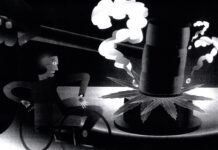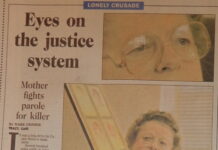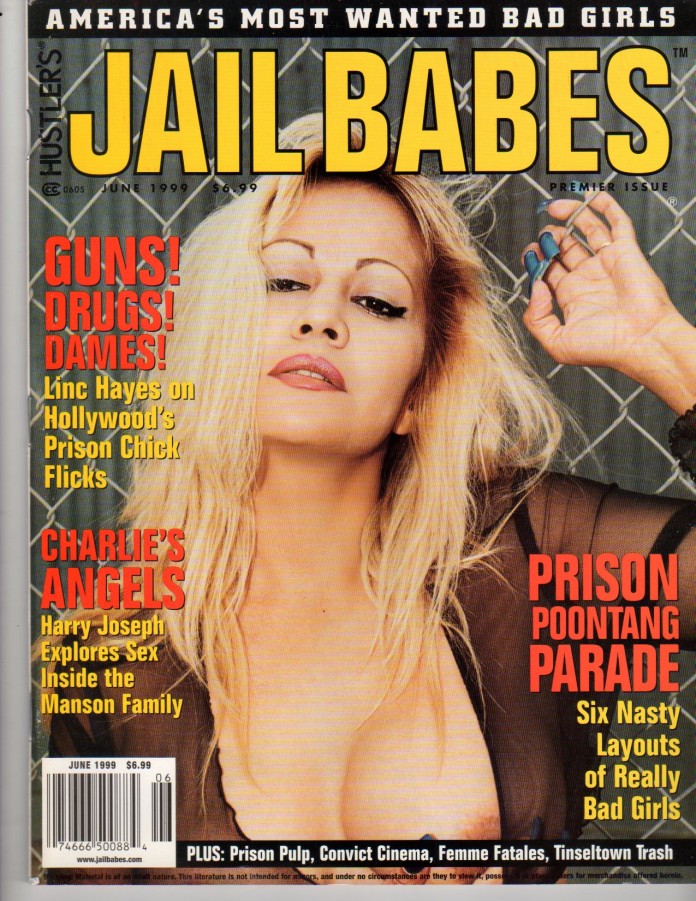
Lost souls, loose lips and sinking ships in Larry Flynt’s LaLa Land
Scenes from a reflection by Mark Cromer
Prologue
[Pomona, California, Autumn of 1975: It’s approaching dusk and I have slipped out of my mom’s apartment and made my way down to the end of the cul de sac. An old shipping pallet that had been stolen from the docks behind Gemco was propped against the cinderblock wall at the end of Benedict Way in the Westwood Apartments and I approach it casually, almost haphazardly, as if I might be heading somewhere else and it just caught my attention for a moment. I cast a quick look over my shoulder to make sure no one is watching and then bound up the pallet, using it like a ramp to scale the wall, pausing for a few seconds to survey the landscape on the other side, before slipping over and dropping quietly to the ground like a defector crossing from East Germany into a no-man’s land of uncertainty and discovery. I make my way across a sprawling undeveloped tract of land just south of the 10 Freeway, walking toward Indian Hill Boulevard, looking for the boulder markers we had laid out a week or so before as we dug our earthen club house. The traffic from the freeway and a light breeze overtakes and offers cover for any other sounds that might be coming from the field, such as hushed voices emanating from a concealed subterranean cubby hole, which is precisely what I am looking for amid the expanse of weeds and dirt. I spot a small rim of rocks up ahead and after a few more paces can make out a hairline slice of darkness that interrupted the ground for about five feet. Drawing closer, I can see brief flashes of light run occasionally hitting the lip of dirt that faced me. I carefully put my foot over the dirt and weed covered board that served as a camouflaged roof to our lair, and then tapped a couple of times. “It’s me,” I said, looking along the cinder block wall behind me one more time to see if anyone was watching me. “Let me in.” With that the crack in the ground suddenly yawned open as the covering board was pulled back and I quickly jumped inside something I realized was more grave than clubhouse, but it would do. As my eyes adjusted to the glow given off by a couple of flashlights, the crouched bodies and beaming faces of Darnell, Lance and Darren came into focus, standing out from the dirt walls. And through the dusty air also came the glint of the gold that we had been mining for months, the shine of the high gloss covers of a stack of magazines in the center of our clandestine ditch, their titles speaking of the mother lode found on their pages; Penthouse, Gallery, Oui, Players and others that were less cryptic, like Orgy and Tits. My friends already have their chosen fare in their laps and the flashlights illuminated the flipping pages as well as the awe-struck look on their faces, which had to resemble that of Ponce de Leon’s at the prospect of finding a map to the fountain of youth. I fish a magazine out of the pile and gaze at the cover for a moment, Hustler, and think ‘I wonder what’s inside?’]
“If you, then, will worship me, it shall all be yours.”
—Satan, from Luke 4:7
When you make a deal with the devil, it pays as such.
The idea of that axiom, if not the exact words themselves, was flitting vaguely through my mind as I leaned back in a leather chair and looked deep into the Pentecostal blue eyes of the man behind the desk in front of me. I knew what I was getting into, or at least I thought I did. As with all things in Los Angeles; this day, this moment, this very instant was all about a deal. About making a deal. Striking a bargain, as you might say.
And shaking on it.
In this case, it was a deal that would likely leave me rich. Or at least that was my plan.
Filthy rich, in fact, since I was signing on the dotted line with the Grand Daddy of modern American pornography: Larry Flynt. The backwoods hick who’d taken a newsletter for his chain of second-rate titty bars in the early 1970s and turned it into Hustler, a skin magazine that had first found its audience as the anti-Playboy: pedestrian scribble wrapped around pictorials featuring his Kentucky strippers. In an era when newsracks still beckoned like an Oklahoma prairie during the land rush, Flynt had unabashedly staked his claim by proudly declaring his magazine was indeed “for the rest of the world” — becoming the first pornographer to delineate ‘fly over country’ from the cosmopolitan coasts that Hugh Hefner and Bob Guccione had been pandering to for a generation by the time Larry arrived. While the urbane Hefner and Gucionne had long enjoyed pretending that they were bringing the good life—or at least pictures of it—to the common man (and Hefner and Guccione no doubt used terms like ‘the common man’ among their Gold Coast and Manhattan cocktail parties with all the aplomb that their pipe-smoking sycophants could afford to stomach), Flynt decided to state the obvious and demarcate the aesthetic prerogatives of the working class in the pages of Hustler. He offered a raised middle-finger for the mavens of all things hi-brow to either salute, or, in the alternative, to suck on.
Unsurprisingly, not many people either saluted or knelt mouth agape in front of those first issues of Hustler, but like any vandal with a penchant for throwing rocks through stained glass windows—and Playboy and Penthouse were both holy houses of prurient worship by 1974—Flynt began to draw attention to himself; and that gave him a little sampler taste of the better-than-Coke rush that jolted Narcissus way back when. And he just had to have more. And more.
A quarter of a century later, Flynt’s penchant for making a name for himself had paid its dividends handsomely, he accumulated a pile of cash that reached the altitude of the Andes and indulged a long-evolving bacchanal that allowed him to gorge on women like so much smoked salmon. It also left him in a wheelchair after a bullet slammed into him and shredded his cauda equina, the bundle of nerves at the base of his spinal cord. As if to celebrate that bitter trade, Flynt had his wheelchair gilded, perhaps as a garish sendoff to his legs and a welcome to a world that saw him pushed around by hulking bodyguards thereafter, the golden gimp lost amid the smoldering glow of his carnal kingdom. The steep price he’d paid for the spoils that he reaped took its toll on his mind as well and there were whispers suggesting that Flynt had devolved into a bloated and bellicose Caesar who was now surrounded by a cocoon of conniving sycophants that had given themselves titles like ‘adjutant’ and ‘aide-de-camp.’
I had begun to hear those whispers the year before, when I first met Bruce David while researching a story for the LA Weekly about the failure of Flynt’s innovative magazine Rage, which was one of his last seriously legitimate efforts to return to prominence on the national stage as a publisher more than a circus oddity. David was the acerbic New York writer that had developed a name for himself among some wildly divergent circles in Gotham during the mid-to-late 1960s, an era that took him from coffee houses where he was writing with Hugh Romney (before he morphed into ‘Wavy Gravy’ at the Hog Farm) and Paul Krassner to serving as Andy Warhol’s art director for the first couple of issues of Interview; before David eventually descended into the emerging smut papers that were becoming ubiquitous in Mayor John Lindsay’s New York City. David eventually went to work for Al Goldstein at SCREW before being approached by Flynt to join him as the editor of Hustler.
By the late 1970s Bruce David had become Larry Flynt’s editorial right hand man, harnessing Flynt’s desire to be increasingly outrageous and filtering it through his own particular brand of clever misogyny. David’s entrée into journalistic and literary circles afforded Flynt at least the sheen of being a pornographer of some consequence—with David bringing the likes of Charles Bukowski to Hustler’s pages and tapping Jay Levin from the New York Post to run Flynt’s newly acquired LA Free Press. It was Bruce David who dreamed up what became one of Flynt’s most darkly iconic images: the infamous Hustler ‘meat-grinder’ cover that featured a woman’s legs sticking out of a sausage-maker; being literally ground up. As David later remarked to me “The feminists were saying we treated women like meat. So I said, ‘OK, let’s visualize that literally and shove it right back in their faces.’”
Bruce David effectively ran Hustler with Althea Flynt for a couple of years after Larry was shot, building the magazine’s circulation past two million newsstand copies sold each month, but he eventually pulled the plug as Flynt’s post-shooting mania blossomed into something darker and far more dangerous. The transition seemed flawless at first, with David landing a deal for a pilot at CBS with Richard Belzer, and after that tanked, writing stints on such hit television shows as Alf and Family Ties, but by the mid-1990s his Hollywood fortunes were running dry and, now with a family of his own, David placed a call to his old boss that he had hoped he would never have to make: Did Larry have anything for him? Bruce was hungry for work and, as Larry could tell, getting desperate. The first thing Larry did for him, Bruce recalled years later, was summon him to his Beverly Hills office, where he produced a stack of cash, $30,000 in cold bills, and gave it to Bruce with no strings attached. A little something that would hold him over and water his garden during this dry spell.
But as it turned out, Larry also did have a new project that he saw David as a perfect fit for; a “cutting edge” magazine that at its core was conceptualized as accomplishing something for Flynt that Hustler had fallen short of: seamlessly bridging the gap between pornography and mainstream quality editorial content—and thus achieving the respectability that Flynt was sure would follow. The magazine was to be called Rage and David’s reaching out to Flynt seemed providential given Larry’s desire to launch his new title.
Bruce David and Larry Flynt were back together again.
In those first heady months of 1995 as the creative team was being assembled and the magazine designed, it probably seemed to Bruce that Rage was truly going to be a different publication for Flynt. Larry was finally doubling down in a real effort to launch a magazine would redefine the boundaries between hardcore smut and refined eroticism, perhaps blurring those lines even further than better demarcating them. For Bruce, it was clearly a chance to not only earn some decent scratch—though only a pittance of the $150,000 annual salary he had once commanded at Hustler—but to jump back into the magazine game by making a serious splash alongside some artistic heavyweights. Graphic design superstar Mike Salisbury was brought in to develop Rage’s look and was given free rein to create, in effect, the anti-Hustler. Salisbury had developed the ‘Joe Camel’ campaign for R.J. Reynolds, designed Rolling Stone for Jann Wenner and conceptualized the branding behind the 501 ad campaign for Levi Strauss. When Larry tapped Salisbury to design Rage, it was clear he meant business. Bruce later said that Larry paid Salisbury more than a million dollars to design Rage. He was taking money from where his mouth had been and was reinvesting it into where Bruce’s literary wet dream lay: a sex mag with a literary brain.
Flynt, Bruce, Salisbury, Jim Kohls and the creative team they assembled around them toiled into early 1996 to put the magazine together, an undertaking that did not go unnoticed by the staff at Hustler and the numerous other second and third-rate skin rags Larry was publishing by then (a rather sordid stable that included such titles as Chic, Barely Legal, Taboo and Hometown Honeys), all of which were vying for the limited resources earmarked for editorial budgets. As existing magazine staffs had to squabble and scratch with Flynt and Kohls for every extra dollar they could get—and there weren’t that many—Rage was sucking up millions of dollars in its development and launch. The low boil of animosity that began to steam up the windows of the editorial offices might have set off alarm bells at most other publishing houses, but the conniving and subterfuge was old hat to Larry and Bruce—preferred operating conditions.
In the high summer of 1996, Rage Vol. 1, Issue 1, landed on newsstands across America. And the trouble started immediately. By all accounts the magazine’s cover was a portent of what the reader would find inside: Aaron Chang’s cover shot catches model Kristina Brown crouching on her haunches, perhaps as she would while relieving herself while in the woods; hands placed on the floor in front of her, dressed in a leopard pattern bra, black bicycle shorts and wearing unlaced combat boots for good measure. She had Band-Aids on both knees. Deep blue mascara surrounded her eyes and a shock of black hair mussed punk rock topped her head. Brown’s frozen face stares out from the cover, her lips fixed open somewhere between an invitation from Linda Lovelace and an Elvis snarl.
A crimson Rage logo dominated the upper left of the cover; and directly across from it came Larry Flynt’s invocation: “It’s new. It’s nasty. It’s not your father’s magazine.”
No, it definitely wasn’t dad’s girlie mag.
A thin green line at an almost unreadable font size rolled like a wave across the legs of cover model Kristina Brown. It offered an opaque if intriguing cast of characters to be found, presumably, inside the magazine: “Howard Stern, Harlan Ellison, Poppy Z. Brite, Roderick Thorp, Bill Murray, Julie Strain, Jim Rose Circus and Mike Salisbury.” And perhaps to underscore this was a different sort of offering from Larry Flynt altogether, the swirling honor roll on the cover also announced “Bart Kosko, Ph.D.” The pornographer whose penchant for showing pink was now promoting his contributor’s doctorate degrees.
Newsstand vendors across the nation who opened the review copy to inspect the magazine before they put it on their racks must have been mildly perplexed as they gazed at the cover of the first issue of Rage. Gone were the magazine cover lines that had long been the mainstay of Flynt’s flagship Hustler and its downstream sister porn mags; those bold enticements that screamed lurid inducements like “Orgies!” and “Kink!” and “Depraved Acts!” with all the aplomb of a carnival barker ushering the paying stiffs into the carnal Big Top.
No, there was just a small sign hanging from this strange door, and the most provocative word on it was “Nasty.”
But it was that, too.
As they flipped through the pages of Rage, no doubt vendors at first blush were caught off guard and found themselves somewhere between truly impressed to downright blown away. Woven throughout Salisbury’s cutting edge design were indeed such big gun writers as Harlan Ellison, Roderick Thorp and Poppy Z. Brite, but also a series of photo sets that while “hardcore,” looked like something more akin to a Calvin Klein ad shoot— where the models dosed on ecstasy and went berserk—than anything they had seen before in Hustler. Making ample use of black and white photography, Rage gleefully burned the template of cookie-cutter model layouts that were virtually indistinguishable from each other and established its own flow; with every photo set looking completely different than any other in the issue. It gave readers the sense that each set could have come from a different magazine; like X-rated versions of Vogue, Car & Driver and Better Homes & Garden that were ginned up with some art house flair and a small dose of noir.
With his opening salvo, Flynt, along with Bruce David and Mike Salisbury, had clearly delivered what they set out to do: push the envelope in porno publishing and in the process establish a vibrant new niche in a market that had long been saturated with titles ostensibly catering to virtually every taste—right down to Nugget, the magazine for the discriminating connoisseur who enjoy watching amputees have sex.
“It is our hope and belief that reading Rage will be a transforming experience,” Bruce David wrote in the inaugural issue’s editorial. “A meme that will change the way you think—and the way you look at men’s publishing.” Unfortunately, potentially hundreds of thousands of readers across the American south, up the Eastern seaboard and in various other regions across the country, never got the chance to experience that “meme.” For the centerpiece in that first critical issue Flynt’s desire to push the envelope—no matter how fashionably arty—resulted in a photo layout by Jonathan Lennard dubbed “Shooter” which featured an ode to a .357 Magnum 686 from Smith & Wesson and a woman fellating the gun, before easing its long chrome barrel inside of her. Flynt had selected the photos himself.
Before the issue went to press, Bruce David, Jim Kohls and Vice President of LFP Inc.’s Advertising Perry Grayson had met with Flynt in a desperate bid to dissuade him from running the shots of the girl effectively having sex with a gun. Grayson, a rather dapper man with Madison Avenue sensibilities that seemed thoroughly out of place at LFP, made the case that the photos would kill any shot Flynt had at luring back mainstream advertisers he once had in the early issues of Hustler, mostly tobacco and alcohol. Kohls and Bruce raised the more immediate concern of losing distribution. Flynt’s ability to muscle newsstand distributors had seriously atrophied after he sold off Flynt Distribution Co. a few years earlier to Curtis Circulation amid a cash crunch. Since virtually all of Flynt’s titles lacked any sustainable subscription base (subscribers had never accounted for more than 10-percent of Hustler’s paid circulation), access to newsstands and rack space was a life-or-death proposition, especially for a new, unheard of title like Rage.
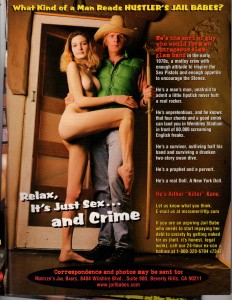
But both Bruce David and Jim Kohls recalled later that it was futile from the outset. “The more we attempted to reason with Larry not to run the photos, the more determined he became to run them,” Bruce remarked. “Come what may.”
What came was disaster. Flynt was bombed with ‘still-births’ (wrapped bundles of the magazine returned unopened from retailers to the distributor) from vendors across the southeastern seaboard unwilling to risk the wrath of local prosecutors by displaying a magazine that had a woman sticking a gun up her vagina. Almost just as bad, many newsstands around the country that chose to stock Flynt’s Rage did so with each issue plastic wrapped so prospective readers would have to buy it before they could look at it. And since the magazine was surrounded on the racks by standard fare targeted to the peculiarities of the “raincoat crowd,” it must have been an odd juxtaposition to see a new magazine stylishly whispering “Bart Kosko, Ph.D.”
So now here I was in porn’s Champs Elysees, looking to sell Larry Flynt an idea of mine. As a 32-year-old journalist who’d been teetering on the edge of bankruptcy for the better part of a year, shaking hands with Larry Flynt on a deal seemed more than just an economic Godsend, but rather the apex of a decade-long journey that I had taken through the back alleys and seedy warrens of the nation’s burgeoning porn scene. It had been a fitful and often crazed jag that led me at times from Los Angeles to San Francisco to New York and back to the City of the Fallen Angel(s) again. Now sporting a haircut, fresh shave, the only suit I had left, wired on a full pot of Maxwell House and softly chewing my Wrigley’s Spearmint as I cooled my heels—it seemed this was the moment I had always been heading toward.
If there was even the faintest whiff of the putrid scent of moral rot drifting through the air vents at that moment, I chose to ignore it. The opulent splendor of my surroundings made that easy enough, just as the seductively luxurious smiles of the female assistants who greeted me stole my attention away from the large brass goats heads that ominously circled the lamps hanging from the ceiling, gazing down at me as I stepped off the elevator on the top floor. I don’t recall hearing the distant echo of agonized screams carried up the elevator shafts, but maybe I wasn’t paying close enough attention.
It was the late morning of August 18th, 1998, and I was on the 10th floor of Flynt’s black glass castle that towers over the intersection of La Cienega and Wilshire boulevards in Beverly Hills. The old home of a Great Western Bank, Flynt bought the building in the mid-1990s and converted it to a corporate headquarters for his publishing empire—slapping Flynt Publications across the top of the building to announce his arrival into a high-end neighborhood, if not actual respectability. Flynt was also careful to keep the larger-than-life bronze statue of John Wayne that stood in front of the building. The celluloid cowboy had been a hollow shill for the regional bank in his sunset years (and the bank’s, as it turned out), but Flynt empathized with the conflicted nature of Wayne’s iconic movie characters: especially Rooster Cogburn; the rugged individual making his own way in a dangerous land as the swaggering gun-slinger who called his own shots and wouldn’t back down. The actual irony of the one-sided admiration was undoubtedly lost on Flynt, who perhaps lost in his Lithium daze could truly see deep similarities between the square-jawed Newport Beach conservative that invariably dispensed with his on-screen opponents with blazing smoke wagons, street cannons and a good old stomping; and the pie-faced pornographer whose limp shooter was now permanently out of bullets and had to fight his enemies with hired gun attorneys. Whether or not Flynt truly fancied himself cut from the same sort of cloth as The Duke, the statue of Wayne—atop his horse and gazing into the distance like a scout trying to eye potential danger—certainly helped commuters and passersby’s make the connection: a hero standing guard at the gate of LA’s anti-hero.
Ten floors up, the hustle of the bustling streets below are muffled through the thick charcoal-stained glass that dims the sunlight to a comfortably muted presence in the offices. The upper floors of the building afford a sweeping view of the Hollywood Hills to the northeast and the glimmering sheen of the Pacific as it snaps off the Century City office towers to the west. Flynt picked the right place for his headquarters. A Kentucky poor boy who has been Hillybilly rich for a long time, moving into West Coast digs that lord over LA’s epicenter of wealth and privilege, the land of make-believe come-to-life and coalescing in a murky swirl around the base of a million tousled palms as the dying gasps of old money sequestered in their Stone Canyon estates can barely be heard over the revving engines of the new aristocracy and the naughty little thrills they race to and from everyday.
This was my chance to get in the game.
I was sitting in the office of Jim Stewart Kohls, President of Larry Flynt Publications—or LFP Inc. as it is widely known in the porn industry. Kohls was not just the gatekeeper to Larry, but the man whom, it had been repeatedly whispered to me, really ran the company. Kohls was said to be the man behind the curtain, pulling the levers and throwing the switches that produced, among the smut fiefdoms, the gaseous bellowing head of Larry’s Oz. Nearly a quarter of a century after he launched Hustler magazine, Flynt himself was by now rumored to be a figurehead, the wounded icon of hardcore who was free to roll around his castle playing make-believe while Kohls and a polished executive staff carried out a now fairly blasé vision of pornography at the turn of the new century.
Tall, with a lion’s face that’s topped with a full head of blonde hair, Kohls had piercing Pentecostal blue eyes that radiated a soothing quality as we shook hands. I took my seat in front of his desk. Behind him were pictures of his wife—an attractive brunette whom had been his secretary before he promoted her to homemaker (after he pink-slipped his first wife) in the best tradition of American business—and assorted accoutrements that subtly broadcast the power and pleasure he had accumulated.
“It’s good to see you, Mark,” he said with a disarming smile. “I’ve been expecting you up here, actually. I figured you’d bring me something sooner or later.”
At first blush Kohls looked like a classic Hollywood pretty boy who had more or less taken care of himself through his salad days, or at least had managed to avoid too many experiments with crystal meth, cheap gin and willing whores. Yet he was still starting to show hints of his 50-plus years, with crows feet and smile lines just starting to make their impression on an otherwise unblemished, lightly tanned face. He could easily pass for one of those nameless actors on a soap opera; the dignified-looking, middle-aged ‘investor,’ or perhaps the handsomely corrupt playboy who seduces his co-ed stepdaughter for the sheer perverse delight of it.
But I had also heard that unlike Flynt, his corporate Rasputin was hardly a true believer in the magic fantasy world of pornography and surely had no interest in becoming a First Amendment martyr. What got Kohls off every time was the bottom line. And porn had an increasingly ripe one. By 1998 he was a veteran, having jumped ship from the Hearst Corporation to join Flynt’s small circulation department at Hustler in the mid-1970s. If Kohls had a vision at all it was apparently his ability to see more long-term opportunity in the then still emerging X-rated theater chains and the adult bookstores that spread across the nation following the release of Deep Throat than he did in the still impressive media empire of the old world Hearst clan. He stayed with Flynt for a few years, putting his time in as a mid-level circulation executive, before bolting to start his own publishing company, Stewart Communications, which published a few second or third-tier skin magazines like Gentleman’s Companion, but never came even close to the trinity of Playboy, Penthouse and Hustler.
But it was only a training run for Kohls.
By the late 1980s, Kohls cut a deal with Flynt to return to LFP Inc.—but this time Kohls would arrive as president of the company as well as Larry’s partner on several side projects, such as the company’s burgeoning phone sex operations. Whatever his true motivation might be, most accounts had it that Kohls was now a savvy shark who knew little and cared even less about editorial quality in a magazine, yet he was an understated killer when it came to clinching business deals that inevitably produced serious money for Larry and him.
I knew, even as I sat there, that I was not just in over my head or batting out of my league by attempting to strike a deal with Flynt and Kohls—I wasn’t even operating in the same solar system as them. Sure, I knew this to be true, but I didn’t particularly care at the time. While I instinctively figured there was a high probability that I was going to be screwed in the process, I was banking on the fact that by the financial standards of Larry Flynt and Jim Kohls; rolling a hungry writer like me would still likely leave me with a cash flow the likes of which I’d never seen before. I considered it akin to when an overnight music sensation makes a million dollars during their brief morning in the popular favor, but still gets ripped off by their evil record company, lawyers and the seedy agents who pocket tens of millions in greenbacks that the ‘artist’ doesn’t even know exists. Sure they got fucked, but it was what I call a relative fucking; they still made a million dollars they almost certainly would not have otherwise. At least that’s what I had kept telling myself on the elevator ride up to Kohls’ office. I figured that while later on down the road I might lose some sleep over getting taken to the cleaners right out of the gate, at least I would have a much bigger, more comfortable bed to toss and turn in.
But I also knew that I had probably just one solid shot to make the sale, though I wasn’t too worried about completely derailing my pitch and blowing it either. I was fairly certain that I had a concept that Kohls and Flynt couldn’t resist. A fresh concept that, in fact, wasn’t really just a rehashed and reformulated take on something that was already on the newsstands.
This was unique.
Kohls leaned back in his leather chair, easily finding his default position somewhere between tensely erect and an un-attentive slouch, and locked his eyes into mine. I had his attention.
“So what do you have for me?”
“Well, there’s only one thing that fascinates and titillates the American people as much if not more than sex, Jim,” I said, winding up and ready to throw. “Only one thing that captivates them more then pure raunch or forbidden sex.”
Kohls eyes hadn’t moved from mine, but he was nodding slightly, not in agreement so much as in anticipation.
“And that would be…” he said, letting his words trail off.
“Well that’s the funny part, because it is so obvious. I mean, it surrounds us everyday, it is sold to us on billboards, in newspapers, in movies and in supermarket checkout lines. The government uses it and it has the power to terrify each and every one of us, which is why our society, I suppose, can never seem to get enough.”
He wasn’t nodding anymore, just staring. I figured I had reached the threshold of his patience, his interest elevated to a crest that would rapidly evaporate if I didn’t hit the punch line now. I pulled the trigger.
“Crime.”
He kept staring for a moment, slowly repeating the word, as if to ensure he had heard me correctly.
“Crime?”
“Yes, crime. Or in this case, fucking crime. Well, fucking criminals, to be more precise.”
His eyes narrowed slightly, refocusing on mine. I could tell the lights were starting to shine a tad brighter deep in that thick German skull of his, synapses beginning to fire on all cylinders as they conveyed the beautiful simplicity of what I was proposing.
“Take the Manson Family for instance,” I proceeded. “The brutality of the Tate-LaBianca murders was a horrific, yes, a chilling nadir indeed to the hedonistic celebration of the free-wheelin’ Summer of Love. Right? You remember the headlines. The news media immediately went for the too easy cliché that the murders marked the epoch of an emerging darkness that would almost fatally contaminate the innocence of the exploration that had been the hallmark of the 1960s. Yet people couldn’t get enough of the details surrounding not only the killings themselves, but of the sordid lifestyle of Charlie and his girls. Ostensibly seeking some greater truth about a bunch of mass killers who went nuts on acid, they demanded every arcane bit of minutia possible about the ritual group sex, the bizarre fetishes of Manson, the robotically submissive nature of his female converts and the surreal blending of sex and violence by The Family. It’s titillation meets terror and everyone from Bantam Books to independent film-makers cashed in on society’s hunger.”
Kohls seemed focused—yet ambivalent. His eyes conveyed that look that told me knew there was now a lot of smoke in the room, but he just wasn’t sure how much fire there was behind it yet. “I might agree with all that,” he said. “But just what are you suggesting?”
I knew that it was time to toss the bones and go for broke. My nervousness was falling away as I spoke and I decided to blend the soft pablum of Madison Avenue jabber with Porn Valley’s hard candy product and hope the result would be music to Kohls’ ears.
Or at least he’d be so confused by what I was actually saying that he’d agree to it anyway because he’d hate to say no to a good idea—even if he didn’t get it.
“Quite simply that we tap into that undying hunger with a vengeance and take it to the next level. We blend sex and crime by delivering a multi-format product that explores the sexuality of female criminals and exploits the American public’s relentless appetite for taking something they want to a whole new level. With a magazine, website and a video series, Larry Flynt Publications Inc. gives the X-rated cliché ‘deep inside’ a sense of refreshed vitality as we go after the girls who are, as it were, in the hole. We will cross-pollinate each platform with promotions; so each issue of the magazine will feature layouts of the women that we get to appear in the videos, and each video will promote the magazine title. The website will offer essentially static promotion of both video and print elements and the prospect of LFP Inc. jumping into the video and online markets under a single product line that is entirely unique; well, I think it is going to be a media bonanza Jim.”
Kohls was smiling now. Those big, brilliant, beautiful white teeth shining like a beacon of light across a dark harbor, beckoning me home.
“ And it’s called Jail Babes.”
“ Jail B-a-b-e-s?”
I saw the slack disappear as the line tightened, the tip of the pole bending downward.
“ Yes, ‘babes.’ If you use the word ‘bait’ it sounds like we’re selling the fantasy of underage girls, which you already do with your magazine Barely Legal, and if you use the word ‘birds’ it sounds too esoteric and dated. ‘Babes’ is an evergreen term, as much in use as a colloquialism now as it was forty years ago. And even if they aren’t ‘babes’ in the traditional sense of the word, the consumer will get the point, which is: these are bad girls getting naked for the camera. And who better to bring it to the masses than Larry Flynt?”
I could hear the line begin to whiz off the reel. He’d bit and was running, but I wasn’t sure if I’d set the hook or not.
“It all sounds very…intriguing, Mark,” he said. “I do like the idea, but it sounds fairly ambitious. Multiple formats, one of which, digital, we are just starting to develop and another, video, that we have never done before at all—only licensing the rights. So where would you propose that we start, specifically?”
“Start? Well, I think we should start immediately of course on all three, simultaneously. There’s no putting one shoe in front of the other here, Jim,” I said. “We’ve got to jump in with both feet. The magazine will take a few months to develop and we can be working on that as we set up the video production. There will be a lot of synergy to feed off creatively with it all happening at once under one roof, with the video and magazine providing each other inspiration.”
I could actually hear myself in an almost out-of-body sort of way at this point, my voice intoning words like ‘synergy’ as I tried to close the deal by waxing what at the time seemed like some sort of semi-savvy business-speak. In some respects I thought it absurd even as I was saying it, and part of me wondered whether Kohls—as close as I seemed I was to getting the deal—would suddenly determine I was an imposter of some sort, cut me off, shut me down and dismiss me with a curt “let me get back to you.” Yet part of me really did believe in what I was saying; really did believe that what the stagnant art of American pornography really needed at this point was something like Jail Babes; radically different in a very raw sense because it was real. And also because, amazingly enough, it had not really been done before, nor had a hardcore porn company simultaneously launched a title across three formats.
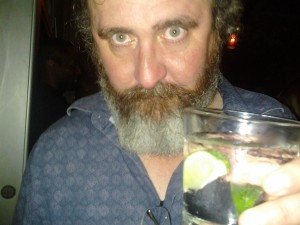
I guess in the end, Kohls heard the part of me that believed what I was saying, and it resonated with him as well.
He leaned back in his chair for what seemed like a perfectly timed pregnant pause, then said “I agree. This is a good project for us and it really is the right time for us as well, since we’re aggressively launching new adult titles. And this, quite frankly, is unique.”
Not wanting to oversell or say something stupid, I just sat there for a moment, trying to comprehend what I had just succeeded in doing.
“What kind of money do you want?” he suddenly asked me.
“Well, I’d like $50,000 a year to edit the magazine and Bruce and I want half of the video company,” I said.
“Yeah, well normally we start our editors at $40K a year for a bi-monthly magazine,” he replied, but I’ll meet you half way and get you $45,000 if that works for you. And yes, we can split the profits from the video.”
“Ok, and the only other thing I want is a piece of whatever phone sex lines and other associated merchandising to the title that’s developed,” I said. “I want a third of that, of whatever we do in that regard.”
Kohls looked at me with just a slight hint of bemusement crossing his face like a tiny ripple in a pond. At the time I took that as a sign that he was perhaps at least momentarily impressed with my negotiating skill; that I had at least some idea where the real money was in all of this. Of course, as I would eventually learn, it was probably much more a flash of casual satisfaction that while I did seem to know where the money could be found, that I actually had the delusional balls to think I was going to negotiate my way into it a real share of it.
“Ok. That’s fine. I’ll have the papers drawn up. When can you start?”
I told Kohls the earliest that I could report was the following Monday, which would give me time to tie up some loose ends and take a few days to try to prepare myself for what it was that I was walking into—as if I really could have. Kohls told me to stop by Human Resources on the 9th Floor on my way out of the building to pick up a package that I would take home with me.
We shook hands and he looked into me for a moment with almost a weary sigh of contentment. “Welcome aboard, Mark.”
“Do I get to meet Larry now?” I asked.
“No, I am afraid not today,” Kohls said. “Though I am sure he will want to meet you when you start next week. I’ll have you up to say hello and make proper introductions soon.”
I turned to leave, making it almost to the door before Kohls’ voice rose from behind me. “Oh, Mark, by the way?”
“Yes, Jim?”
“You do know how to produce porn videos and publish a porn magazine, right?”
“Of course,” I replied. “That’s why I am here. I’ve been waiting for this moment for a long, long time.”
He smiled. “Well, you picked the right place.”
[Hollywood, California, Summer of 1999: I’m upstairs at The Rainbow on Sunset Boulevard, getting ready to introduce Glimmer, the band that along with bassist Arthur Kane from the New York Dolls is playing the launch party of my magazine, website and video series, and I pause for a moment to consider this scene; a booze-adled, coke-fueled very-LA conclave of porn starlets and wannabes, beautiful people and burnouts cavorting with rockers and writers and artists all in celebration of that most primal and revolutionary of personal statements: fucking. I think about Jim Morrison taunting that crowd in the Dinner Key Auditorium on that hot Miami night in 1969 with the sly rhetorical question of ‘What did you come here tonight for? What is it you wanna see?’ Thirty years after Morrison posed that question I realize the answer hasn’t changed a lick. They want to see sex. They want to watch. And in doing so they want lift their torches to all the constructs of shame and guilt that have grown up around it over the centuries. They want to get off in the face of all that repressive fear. They want to fuck and get fucked and get fucked up. I look around and take it all in; the Bolivian powder we scored at The C-Bar a couple nights earlier has smoothed out the vodka nicely and I decide its time to inaugurate the proceedings and get the show underway. I step forward to the microphone and as the crowd quiets down I say ‘Hi, I’m Mark Cromer, I am a fellow hedonist and I am here to help.’ The cheers filled the room. And I knew I was just getting started.]
“Anyone who knows the alleyways and the trash cans knows Hollywood.”
— Charles Manson



